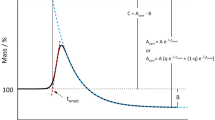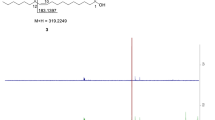Abstract
IN recent years, several research workers have studied the problem, whether cancer of the skin in the tropics could be caused by carcinogenic substances formed in the skin after strong irradiation and whether the high percentage of cancer of the stomach in northern regions was connected with the usual diet and its preparation (for example, heating of fats). In a number of communications, Roffo1 has proved the carcinogenic action by the ultra-violet rays of sunlight, and his results have been corroborated by other authors2. He has put forward, too, the theory3 that a carcinogenic substance may be formed by the action of ultra-violet rays from cholesterine, which accumulates in the skin under the influence of the irradiation. Roffo has tried to strengthen this view by experiments in vitro with cholesterine; however, a definite reaction product has not yet been isolated and, moreover, the chemical evidence given is not convincing4.
This is a preview of subscription content, access via your institution
Access options
Subscribe to this journal
Receive 51 print issues and online access
$199.00 per year
only $3.90 per issue
Buy this article
- Purchase on Springer Link
- Instant access to full article PDF
Prices may be subject to local taxes which are calculated during checkout
Similar content being viewed by others
References
Roffo, A. H., Bol. Inst. Med. Exp. Estud. Cancer(1933–1938), compare Z. Krebsf., 47, 473 (1938).
See literature cited by Bergman, W., Z. Krebsf., 48, 546 (1939).
Roffo, A. H., Z. Krebsf., 47, 473 (1938).
Compare the detailed critical survey by Bergmann, loc. cit. 2.
Waterman, N., Conference Lecuwenhock-Vereeniging V. 86, Paris, 1937 (in details still to be published).
Waterman, N., Acta Cancrologica ii, 5/6, 375 (1936); Nederl. Tijdschr. Geneesk., 81, 1273 (1937); Acta brevia neerlandica, 7, 18 (1937) and loc. cit. 5.
Roffo, A. H., loc. cit. 3.
Domagk, G., Z. Krebsf., 48, 284 (1939).
Widmark, E. M. P., NATURE, 143, 984 (1939).
Compare Dimroth, K., Trautman, G., Ber. 69, 669 (1930). (Formation of a cholestadiene from 7-hydroxy-cholesterine-benzoate).
Staveley, H. E., Bergmann, W., J. Org. Chem., 1, 567, 575 (1936). See also, Eck, J. C., van Peursem, R. L., Hollingsworth, E. W., J. Amer. Chem. Soc., 61, 171 (1939).
Butenandt, A., Kudfuss, H., Z. Physiol. Chem., 253, i (1938).
To be published in Acta Internat. Contra Cancrum.
Bergman, E., Hirsberg, Y., NATURE, 142, 1037 (1938).
Waterman, N., Acta brevia neerlandica, 9, 143 (1939).
Author information
Authors and Affiliations
Rights and permissions
About this article
Cite this article
VELDSTRA, H. Δ 3,5-Cholestadiene from Cholesteryl Oleate and its Possible Bearing upon the Formation of Carcinogenic Substances in Heated Fats. Nature 144, 246–247 (1939). https://doi.org/10.1038/144246a0
Issue Date:
DOI: https://doi.org/10.1038/144246a0
This article is cited by
Comments
By submitting a comment you agree to abide by our Terms and Community Guidelines. If you find something abusive or that does not comply with our terms or guidelines please flag it as inappropriate.



